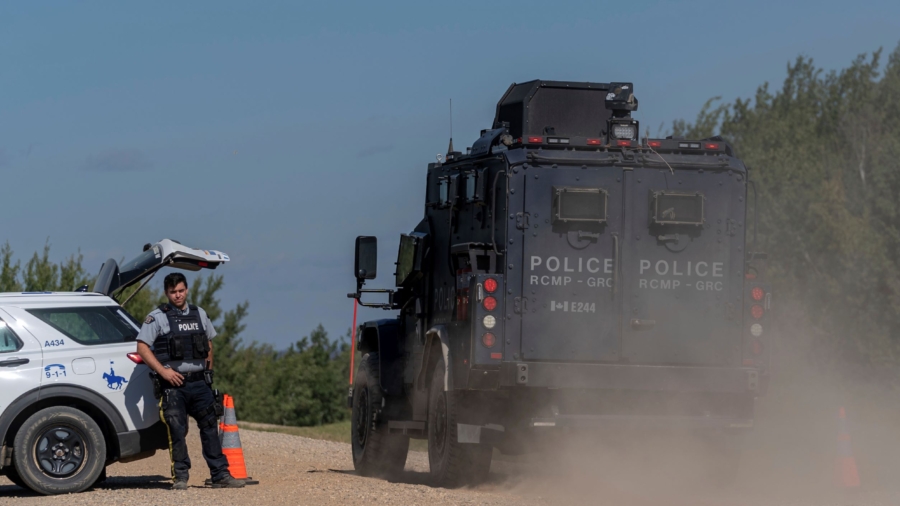JAMES SMITH CREE NATION, Saskatchewan—As a Canadian Indigenous community comes to grips with a deadly stabbing rampage by two of its own, many blamed rampant drug and alcohol use on the reserve that they linked to repeated failures by the government over many years.
One of the alleged attackers, Myles Sanderson, has 59 criminal convictions, according to parole documents. He’d been serving a sentence of four years and four months on charges that included assault with a weapon, assault on a peace officer, and robbery when he was released.
Public Safety Minister Marco Mendicino said he’s been told by the parole board there will be an investigation into its assessment of Myles Sanderson, who remained a fugitive and the subject of a large-scale manhunt on Wednesday.
“I want the know the reasons behind the decision” to release him, he said. “I’m extremely concerned with what occurred here.”
Many of his past crimes happened when he was intoxicated, and he told parole officials substance use made him out of his mind. He had been sought for a parole violation since May.
“The drug problem and the alcohol problem on these reserves is way out of hand,” said Ivor Wayne Burns, whose sister was killed in the weekend attacks. “We have dead people and we asked before for something to be done.”
Sanderson, 32, and his brother Damien, are accused of killing 10 people and wounding 18 others in the attacks that spread across the rural reserve and into the nearby town of Regina. Damien’s body was found Monday near the attacks, and police were investigating whether his brother killed him.
The reserve, population of about 1,900, gets its name from a chief who signed an agreement over lands with the Canadian Crown and other tribes in 1876, according to its website. More tribal members live off the reserve, for about 3,400 members total.
Myles Sanderson’s childhood was marked by violence, neglect, and substance abuse and led to a “cycle of substance abuse, seeking out negative peers and violent behavior,” the parole documents said. He lived between his father’s home in a city and grandparents’ house on a reserve. There was violence and abuse in both households, it said.
Sanderson started drinking and smoking marijuana at around age 12 to cope with problems, the document said. Cocaine followed soon after.
Parole documents said he barged into his ex-girlfriend’s home in July 2017 while she was with friends, punched a hole in the door of a bathroom while his two children were hiding in a bathtub, and threw a cement block at a vehicle parked outside.

He got into a fight a few days later at a store, threatening to kill an employee and burn down his parent’s home, documents said.
That November he threatened an accomplice into robbing a fast food restaurant by hitting him in the head with a firearm and stomping on his head. He then stood watch during the robbery.
In April 2018, he stabbed two men with a fork while drinking and beat someone unconscious.
He got into trouble twice while in prison for having contraband before he was let out in August 2021 on statutory release. But he got into trouble that year and had his release changed for failing to be honest with his parole supervisor about continuing what he acknowledged was a “rocky” relationship with his common-law spouse.
Myles Sanderson said his childhood “normalized substance abuse and violence.”
But he said he’d “stayed sober, found employment assisting an Elder, arranged for a therapist to deal with domestic violence and other issues.” And in February, the board allowed him out of prison, while adding conditions to limit and monitor contact with his spouse and children.
Parole documents also stated he should not enter into relationships—either intimate or non-sexual—with women unless he had prior written permission from his parole officer.
“It is the Board’s opinion that you will not present an undue risk to society if released on statutory release,” parole documents said.
But officials say he violated parole, and in May, a Crime Stoppers bulletin was issued for Sanderson, warning he was unlawfully at large.
Sharna Sugarman, who was organizing a GoFundMe for the victims, questioned the parole board for releasing him and why Sanderson was still on the loose so many months after he was deemed “unlawfully at large.”
“That’s just egregious to me,” said Sugarman, a counselor who worked in the community in 2010 and 2011 and counted one of the stabbing victims—Gloria Lydia Burns—as a client. “If they claim that they’ve been looking for him, well you weren’t looking that hard.”
Mendicino, Canada’s public safety minister, said he wants “to know if any mistakes were made during the (parole) process.”
“It has to be an independent review,” he said.
By Rob Gillies and Robert Bumsted

